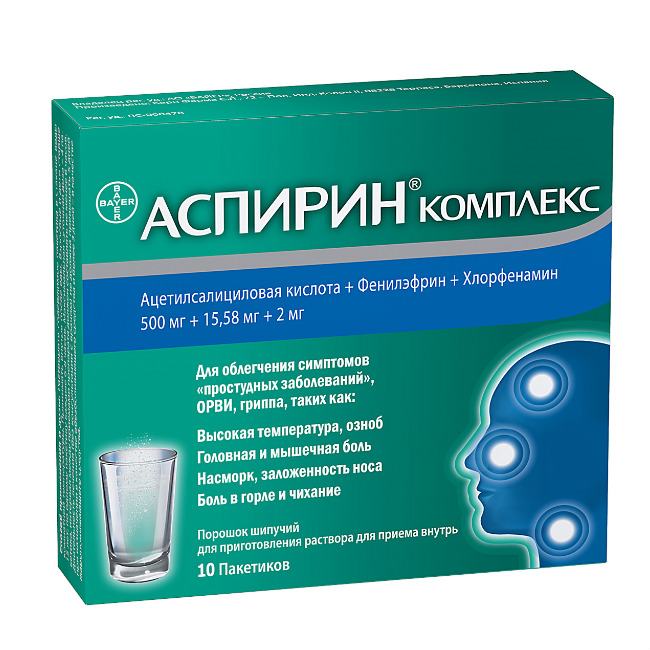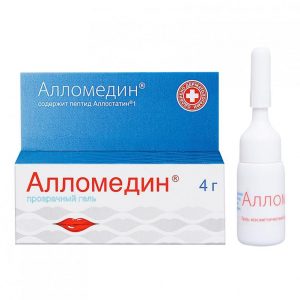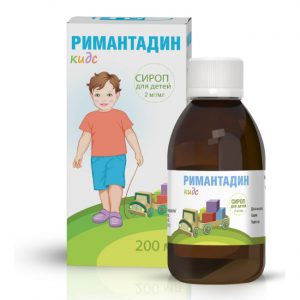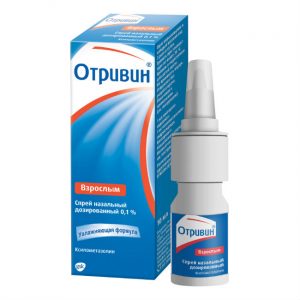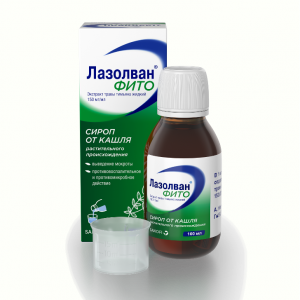Description
Latin name
Aspirin complex
Release form
Effervescent powder for solution for oral administration.
Packing
10 pcs
Pharmacological action
Aspirin Complex – a combined preparation.
Acetylsalicylic acid has an antipyretic, analgesic and anti-inflammatory effect, and also reduces platelet aggregation.
Phenylephrine is a sympathomimetic and, having a vasoconstrictor effect, reduces swelling of the mucous membranes of the nose and paranasal sinuses, making breathing easier.
Chlorphenamine – a blocker of histamine H1 receptors, has an anti-allergic effect: eliminates itching (including the eyes, nose), swelling and hyperemia of the mucous membranes of the nasal cavity, nasopharynx and sinuses, reduces the effects of exudation.
Indications
Use to relieve symptoms of the common cold, SARS, the flu, such as fever and chills, headache and muscle pain, runny nose and / or nasal congestion, sore throat and sneezing.
Contraindications
acute and recurrent erosive-ulcerative diseases of the gastrointestinal tract
hemorrhagic diathesis
bronchial asthma, salicylate and NSAID-induced
combined use with methotrexate at a dose of 15 mg per week
renal failure
hepatic insufficiency in the decompensation stage
arterial hypertension
angina pectoris srdlkrd lactation enlarged srdlkrd and erythroma srdlkrd and erythroma )
hypersensitivity to acetylsalicylic acid, other salicylates or any components of the drug.
The drug is not prescribed for children under the age of 15 years with acute respiratory infections caused by viral infections, because of the risk of Reye’s syndrome (encephalopathy and acute fatty degeneration of the liver with acute development of liver failure).
With caution, the drug should be prescribed for gout, hyperuricemia in patients with a history of gastrointestinal ulcer (including gastric and duodenal ulcer) or gastrointestinal bleeding, impaired renal and hepatic function, bronchial asthma, chronic diseases respiratory organs, hay fever, polyposis of the nasal mucosa in case of allergic reactions to drugs (including NSAIDs), in the second trimester of pregnancy.
Use during pregnancy and lactation
Contraindicated in pregnancy and lactation.
Composition of
Each packet contains:
active ingredients:
acetylsalicylic acid – 500 mg,
phenylephrine hydrotartrate – 15.58 mg,
chlorphenamine maleate – 2.00 mg
acid, sodium hydrogen chloride,
1709.6 mg,
lemon flavor 100 mg,
quinoline yellow dye (E 104) 0.32 mg.
Dosage and administration
Adults and children over 15 years of age are prescribed 1 sachet every 6-8 hours. The maximum daily dose is 4 sachets, the interval between doses should be at least 6 hours.
Duration of treatment (without consultation with doctor) should not exceed 5 days when used as an anesthetic and more than 3 days – as an antipyretic.
The drug should be taken orally after a meal, after dissolving the contents of the sachet in a glass of water at room temperature.
Side effects of
From the gastrointestinal tract: nausea, anorexia, pain in the epigastric region in some cases (especially with frequent and prolonged use of the drug) are possible – erosive and ulcerative lesions of the gastrointestinal tract, hidden blood loss from the gastrointestinal tract, signs of gastrointestinal bleeding (tarry stool )
From the hemopoietic system: very rarely – thrombocytopenia, anemia (due to hidden bleeding from the digestive tract).
Allergic reactions: rarely (especially in patients with bronchial asthma) – skin rash, bronchospasm.
Drug Interaction
Acetylsalicylic acid
Combination with Methotrexate at a dose> 15 mg per week is contraindicated. Combinations of drugs used with caution: Methotrexate at a dose of less than 15 mg / week: At the same time, the drugs increase the hematologic toxicity of methotrexate due to the fact that NSAIDs generally reduce the renal clearance of methotrexate, and salicylags, in particular, displace it. .
Anticoagulants (coumarin, heparin): the simultaneous intake of ASA and indirect aticoagulants increases the risk of bleeding due to suppression of platelet function, damage to the gastric mucosa and 12 duodenum and displacement of oral anticoagulants.
Other NSAIDs with salicylates in high dose (at a dose of 3 g / day or more): with the simultaneous use of drugs due to the effect of synergism increases the risk of ulceration of the gastrointestinal tract and bleeding.
Uricosuric drugs (probenecid, sulfinpyrazone): The therapeutic effect of uricosuric drugs is reduced by competitive tubular elimination of uric acid.
Digoxin: with concomitant administration of drugs, the plasma concentration of digoxin is increased by reducing its excretion.
Antidiabetic drugs (insulin, sulfonylurea): The hypoglycemic effect is enhanced by the fact that high-dose ASA has hypoglycemic properties and displaces sulfonylurea from plasma proteins.
Thrombolytics / antiplatelet drugs of other classes (ticlopidine): increased risk of bleeding.
Diuretics in combination with ASA at a dose of 3 g / day or more: reduced glomerular filtration due to a decrease in the synthesis of prostaglandins in the kidneys.
Systemic glucocorticosteroids (GCS) with the exception of hydrocortisone (used to treat Addison’s disease): with concomitant use of drugs, the concentration of salicylates in the blood decreases as GCS enhances the elimination of salicylates.
Angiotensin-converting enzyme (ACE) inhibitors: with the simultaneous use of ACE inhibitors and ASAs at a dose of 3 g / day and more, a decrease in the antihypertensive effect of ACE inhibitors is observed due to a decrease in glomerular filtration.
Valproic acid: ASA breaks the bond of valproic acid with plasma proteins, resulting in increased toxicity.
Alcohol: when combined with ASA, the damaging effect on the mucous membrane of the gastrointestinal tract increases and the bleeding time is prolonged.
Phenylephrine
Monoamine oxidase inhibitors (MAO inhibitors) – with simultaneous use of phenylephrine and MAO inhibitors (antidepressants – tranylcypromine, moclobemide of antiparkinsonian drugs – selegiline)
Beta-blockers – with the simultaneous use of increased blood pressure (hypertension) and severe bradycardia. Sympathomimetics with simultaneous use increases the influence of sympathomimetics on the CNS and the cardiovascular system. Excitation is possible, irritability, insomnia.
Inhalation Anesthetics – The use of fililephrine prior to inhalation anesthesia increases the risk of heart rhythm disturbance. Treatment with phenylephrine should be discontinued a few days before scheduled surgery.
Rauwolf alkaloids – the therapeutic effect of phenylephrine may be reduced when used concomitantly.
Caffeine – the therapeutic and toxic effects of caffeine can be increased when used simultaneously.
Indomethacin, bromocriptine – Severe arterial hypertension is possible in isolated cases when phenylephrine is used concomitantly with indomethacin or bromocriptine.
Selective serotonin reuptake inhibitors – when co-administered with antidepressants in this group (fluvoxamine, paroxetine, sertraline) may increase both the body’s sensitivity to sympathomimetics and increase the risk of serotonergic effects.
Hypotensive drugs from a group of sympatholytics such as reserpine, guanethidine – phenylephrine reduce the hypotensive effect of these drugs.
Chlorphenamine
Alcohol, sleeping pills, tranquilizers, antipsychotics (neuroleptics), neutral analgesics – chlorophenamine can enhance the depressant effect of these drugs on the CNS.
Anticholinergic drugs (atropine, antispasmodics, tricyclic antidepressants, MAO inhibitors, antiparkinsonian drugs) – chlorphenamine enhances the anticholinergic action of these drugs.
Overdose
Symptoms: nausea, vomiting, ringing in the ears, impaired hearing and vision, shortness of breath, severe headache, impaired balance, severe drowsiness, heart rhythm disturbance.
Treatment: gastric lavage, administration of activated charcoal, symptomatic therapy.
Storage conditions
The drug should be stored at room temperature. Keep out of the reach of children.
Do not use after expiration date.
Expiration
4 years.
Deystvuyuschee substances
Atsetylsalytsylovaya acid phenylephrine, CHLORPHENAMINE
Dispensing conditions from pharmacies
Over-the-counter
Prescription
Prescription
For pregnant women only II trimester as prescribed by a doctor, For adults, Children older than 15 years
Bayer Pharma AG, Germany
